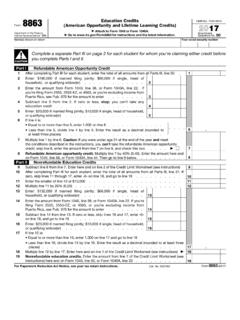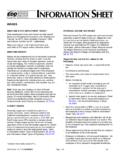Transcription of UNDERSTANDING THE FINANCIAL AID PROCESS
1 UNDERSTANDING THE FINANCIAL AID PROCESS . PRESENTED BY RENEE NUNZIATO, DIRECTOR OF FINANCIAL AID, SUFFOLK COUNTY COMMUNITY COLLEGE. DO YOU FEEL THIS WAY NOW? TYPES OF FINANCIAL AID. Free money Scholarships typically merit based Grants typically need based Self-help Student loans Parent loans Employment (Work Study). HOW IS ELIGIBILITY DETERMINED? Aid is awarded based on FINANCIAL need, merit, or a combination of both He who gives out the money makes the rules Filing the FAFSA determines how much a family can contribute (in theory).
2 NYS a bit simpler based on income and enrollment status Institutional could be need-based, merit based or both, athletic, academic major, etc. PHILOSOPHY OF NEED-BASED AID. Paying for college is a partnership between the student, family and awarding agencies First responsibility of student and family Aid is a supplement to family resources WHO PROVIDES INFORMATION ON THE APPLICATION? The student is the applicant Is considered dependent and must provide parental information unless: Federal State Veteran or active duty Married Married 35 years of age or older Have children or dependents they support 22 years or older and: does not reside with They are an orphan, ward of the court, in parents, does not more than $750 in FINANCIAL foster care or legal guardianship support, has not and will not be claimed as They are 24 years of age as of 1/1/18.
3 Depended on taxes Under 22 same as above plus other special They are designated as homeless by a high school or other government agency conditions (ward of court, orphan, parental rights relinquished, etc.). WHO IS A PARENT ON THE APPLICATION? Biological or adoptive parent(s). If parents are divorced or separated, the custodial parent (where the student lives, not who claims them on taxes). If custodial parent is remarried, step-parent is included on the application If biological parents live in the same house, they both must be on the application No one else is the parent!
4 HOW TO APPLY. Deadline Dates - Admission & FINANCIAL Aid deadlines are usually different Each school may require different forms FAFSA Free Application for Federal Student Aid (federal). CSS Profile College scholarship Service Profile (private institutions). State Aid applications TAP, Excelsior, STEM, etc. Institutional forms HOW TO APPLY FEDERAL AID. Need FSA ID and password for both student and parent Do not use same email address! HOW TO APPLY FEDERAL AID. Available October 1st each year Beginning with 2017-2018 and beyond, use prior-prior year tax info 2018-2019 based on 2016 tax information Can use IRS data retrieval tool Imported data is masked and cannot be changed Can list up to 10 schools don't need to wait until they are accepted HOW TO APPLY STATE AID (TAP).
5 Small link on confirmation page of FAFSA, or HESC will send email when ETA is available to complete NY residents attending NY school Income limit of $80,000 NTI. Awards range from $500 to $5,165. On right side of screen WHAT ABOUT THE NY FREE TUITION??? EXCELSIOR scholarship . Program started Fall 2017. Full-time at CUNY/SUNY colleges may qualify Program covers up to full tuition or $5,500 (less other grants/scholarships), does not cover fees, room or board AGI limits for family: $110,000 for 2018-2019. $125,000 for 2019-2020 and beyond EXCELSIOR scholarship .
6 EXCELSIOR scholarship . Short window of opportunity to apply (Fall 2017 available form 6/7-7/21). Designed for on-time completion Must take 12 college level credits per semester and complete 30 credits per year to maintain eligibility If a recipient transfers, they must transfer the equivalent of 30 credits per year applicable to their new program Gap in enrollment/change of major could jeopardize meeting annual credit requirements If decertified for not meeting credit requirement/good academic standing, scholarship lost forever 5 page contract must be signed residency requirement equal to length of receipt of award or converts to a loan (limited exceptions apply).
7 ENHANCED TUITION AWARD. For full-time students attending participating independent institutions Can receive up to $6,000 annually with a combination of TAP, ETA and match from institution Same enrollment and residency requirements as Excelsior OTHER STATE GRANTS/SCHOLARSHIPS. DETERMINING FEDERAL AID AWARDS. Completion of the FAFSA results in an Expected Family Contribution (EFC). Need analysis measures ability to pay not willingness to pay. EQUITY APPROACH TO RATION LIMITED FUNDS. Equitable doesn't mean equal! Horizontal Equity consistent treatment of people in similar circumstances Vertical Equity appropriately differing treatment of people in different circumstances Assumption that as FINANCIAL strength increases, more flexibility in how income and assets can be used (larger % of finances are discretionary).
8 DETERMINING FEDERAL AID AWARDS. EFC is subtracted from the cost of attendance (sticker price) of the college, any difference is FINANCIAL need . School ABC School XYZ. COA $32,000 COA $14,000. EFC $15,000 EFC $15,000. Need $17,000 Need $0. HOW EFC IS CALCULATED (DEPENDENT STUDENTS). 4 components 1. Contribution from parent(s) income 2. Contribution from parent(s) assets 3. Contribution from student's income 4. Contribution from student's assets PARENT CONTRIBUTION FROM INCOME. Calculates discretionary income Total income from 2016, taxable and most forms of untaxed income less certain adjustments Federal income tax paid FICA.
9 Employment Expense Allowance State and local tax allowance Income protection allowance (to cover basic needs). PARENT CONTRIBUTION FROM ASSETS. What assets are considered? Cash, savings and checking accounts Net value of business if equivalent of 100 FT employees Net value of any real estate (not including primary residence). Stocks, bonds, mutual funds, 529 Plans, trusts, other investments NOT retirement plans Total value of assets less an asset protection allowance assessed at 12% rate Example of APA: 2 parents, age 40 = $16,800; 2 parents, age 50 $21,200.
10 DEPENDENT STUDENT CONTRIBUTION FROM INCOME & ASSETS. Income after threshold amount (currently $6,420) is assessed at a 50%. Income above threshold may be viewed as contributing to the household if parents are very low income No asset protection allowance, total value assessed at 20%. REALITY AND THE EFC. Federal Government's definition of discretionary income may not coincide with yours NY high cost of living area Some spend more $ on discretionary items than gov't considers necessary You may have $0 contribution from assets but use assets for your family contribution Ex.






